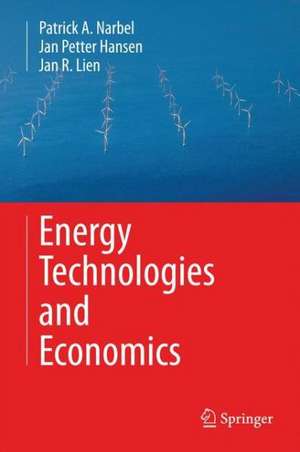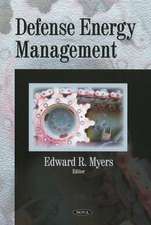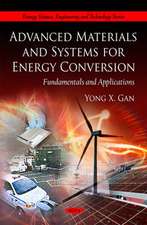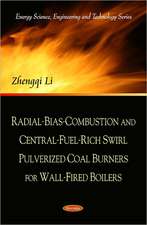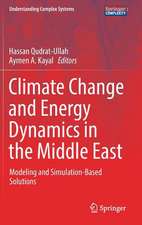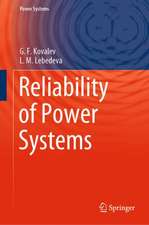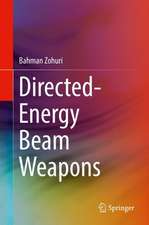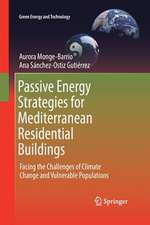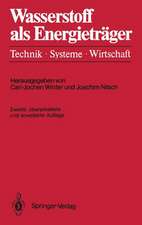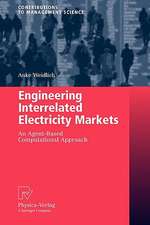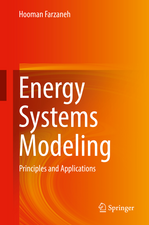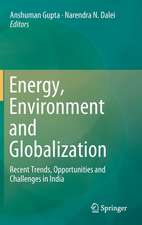Energy Technologies and Economics
Autor Patrick A. Narbel, Jan Petter Hansen, Jan R. Lienen Limba Engleză Hardback – 29 iul 2014
The journey through the book begins with some background theory on the physics and economics of energy. Major energy technologies (fossil, nuclear and renewable) are explored in-depth, explaining how they work and the costs involved. Finally, the journey ends by exploring the technical and economic feasibility of supplying the world by 2050 with sustainable energy only.
Numerous examples are provided to allow the reader to relate important concepts to real-life. The reader’s understanding of the material can then be tested using the exercises at the end of each chapter.
This textbook is the first to thoroughly present the physics and the economics of energy. It is intended for graduate students and practitioners interested in the field of energy. It also enables the general reader to distinguish between political statement and fact.
| Toate formatele și edițiile | Preț | Express |
|---|---|---|
| Paperback (1) | 441.51 lei 6-8 săpt. | |
| Springer International Publishing – 17 sep 2016 | 441.51 lei 6-8 săpt. | |
| Hardback (1) | 475.93 lei 6-8 săpt. | |
| Springer International Publishing – 29 iul 2014 | 475.93 lei 6-8 săpt. |
Preț: 475.93 lei
Preț vechi: 559.92 lei
-15% Nou
Puncte Express: 714
Preț estimativ în valută:
91.08€ • 94.74$ • 75.19£
91.08€ • 94.74$ • 75.19£
Carte tipărită la comandă
Livrare economică 12-26 aprilie
Preluare comenzi: 021 569.72.76
Specificații
ISBN-13: 9783319082240
ISBN-10: 3319082248
Pagini: 265
Ilustrații: X, 255 p. 127 illus., 43 illus. in color.
Dimensiuni: 155 x 235 x 17 mm
Greutate: 0.55 kg
Ediția:2014
Editura: Springer International Publishing
Colecția Springer
Locul publicării:Cham, Switzerland
ISBN-10: 3319082248
Pagini: 265
Ilustrații: X, 255 p. 127 illus., 43 illus. in color.
Dimensiuni: 155 x 235 x 17 mm
Greutate: 0.55 kg
Ediția:2014
Editura: Springer International Publishing
Colecția Springer
Locul publicării:Cham, Switzerland
Public țintă
Upper undergraduateCuprins
Preface.- Basic Physical Processes and Economics.- Fossil Energy Systems.- Nuclear Energy Systems.- Renewable Energy.- Outlook.- Bibliography.
Notă biografică
Patrick A. Narbel obtained his PhD from the Norwegian School of Economics. He has researched the economics of energy, the efficiency of policy instruments facilitating the deployment of intermittent renewables and future prospects of these technologies. Patrick is a council member of the International Association for Energy Economics.
Jan Petter Hansen is a professor of the University of Bergen, Norway and adjoint professor of the Norwegian School of Economics. At both places he is teaching basic physics related to energy. He has published more than 100 scientific papers and is currently a board member of the Norwegian Physical Society (NFS).
Jan R. Lien is professor emeritus from the University of Bergen, Norway. He has been teaching and doing research in both nuclear physics and petroleum technology, and has several research terms abroad. He is a member of the Society of Petroleum Engineers (SPE) and the Norwegian Physical Society (NFS).
Jan Petter Hansen is a professor of the University of Bergen, Norway and adjoint professor of the Norwegian School of Economics. At both places he is teaching basic physics related to energy. He has published more than 100 scientific papers and is currently a board member of the Norwegian Physical Society (NFS).
Jan R. Lien is professor emeritus from the University of Bergen, Norway. He has been teaching and doing research in both nuclear physics and petroleum technology, and has several research terms abroad. He is a member of the Society of Petroleum Engineers (SPE) and the Norwegian Physical Society (NFS).
Textul de pe ultima copertă
This is an easy-to-read textbook providing the reader with the basis to comprehend the major energy technologies from a physical and economical perspective.
The journey through the book begins with some background theory on the physics and economics of energy. Major energy technologies (fossil, nuclear and renewable) are explored in-depth, explaining how they work and the costs involved. Finally, the journey ends by exploring the technical and economic feasibility of supplying the world by 2050 with sustainable energy only.
Numerous examples are provided to allow the reader to relate important concepts to real-life. The reader’s understanding of the material can then be tested using the exercises at the end of each chapter.
This textbook is the first to thoroughly present the physics and the economics of energy. It is intended for graduate students and practitioners interested in the field of energy. It also enables the general reader to distinguish between political statement and fact.
The journey through the book begins with some background theory on the physics and economics of energy. Major energy technologies (fossil, nuclear and renewable) are explored in-depth, explaining how they work and the costs involved. Finally, the journey ends by exploring the technical and economic feasibility of supplying the world by 2050 with sustainable energy only.
Numerous examples are provided to allow the reader to relate important concepts to real-life. The reader’s understanding of the material can then be tested using the exercises at the end of each chapter.
This textbook is the first to thoroughly present the physics and the economics of energy. It is intended for graduate students and practitioners interested in the field of energy. It also enables the general reader to distinguish between political statement and fact.
Caracteristici
Provides students with a concise but complete introduction to energy technology Takes both the physical and the economic perspective into account Contains numerous exercises Also suitable for journalists, governments and industrials seeking for orientation in the field of energy Includes supplementary material: sn.pub/extras
